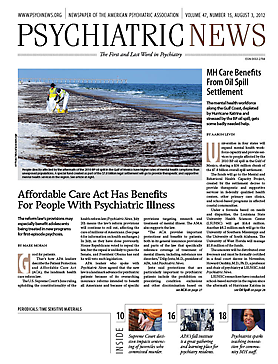APA has launched a new Web site dedicated to presenting accurate information about DSM-5 and rapidly correcting misinformation that appears in the mainstream media, opinion pages, and “blogosphere.”
DSM-5 Facts, at
www.dsmfacts.org , complements the existing official
DSM-5 Web site that has been operating since 2010; that site,
www.dsm5.org, includes the names of the numerous experts who are working on
DSM-5 and documentation regarding research findings related to proposed criteria. “This is a really expansive site with hundreds of pages of links,”
DSM-5 Task Force Chair David Kupfer, M.D., said.
The new Facts Web site focuses on media treatment of DSM-5. “There has been a great deal of comment in the world of blogs as well as mainstream media,” APA Medical Director James H. Scully Jr., M.D., told Psychiatric News. “The information has been very mixed in terms of accuracy, so we thought it was important to have a place for members and others to get accurate, timely information.”
Kupfer said, “The idea for the Web site grew out of discussions with members in the APA Assembly, who expressed the need for an easy place to go for factual information about DSM and for a rapid response to items that appear in the mainstream media.”
The main page of the new site contains “Key Facts” about DSM-5, some of which have been obscured in the media. These include the following:
DSM-5 is not final. Draft criteria will be further refined based on a number of factors, including the public comments APA received via DSM5. org, field-trials data, internal evaluations, and a final review by APA’s Board of Trustees.
DSM-5 provides a common language for communication about mental disorders. The goal in developing DSM-5 is to produce an evidence-based manual that is useful to clinicians in helping them accurately and consistently diagnose mental disorders.
DSM-5 has been an open and inclusive process. DSM-5 represents the contributions of more than 700 distinguished mental health and medical experts during an extensive and rigorous 14-year development process. The draft criteria have been opened for public review and comment via DSM5. org three times throughout the development process to ensure broad perspectives were considered.
DSM-5 will not increase the number of mental disorders. In fact, as it is slated right now, there will be fewer disorders in DSM-5 than in DSM-IV. Also, relatively few diagnoses are changing substantially from the past edition.
Additionally, the main page of the new Web site includes links to an article by Kupfer that appeared on Medscape; a response to allegations that appeared in a recent op-ed piece in the
New York Times; a correction of some misstatement of facts in a news article that appeared in the
Times; and a link to a factually accurate article about
DSM-5 proposals for autism spectrum disorder that appeared in the
Wall Street Journal.

